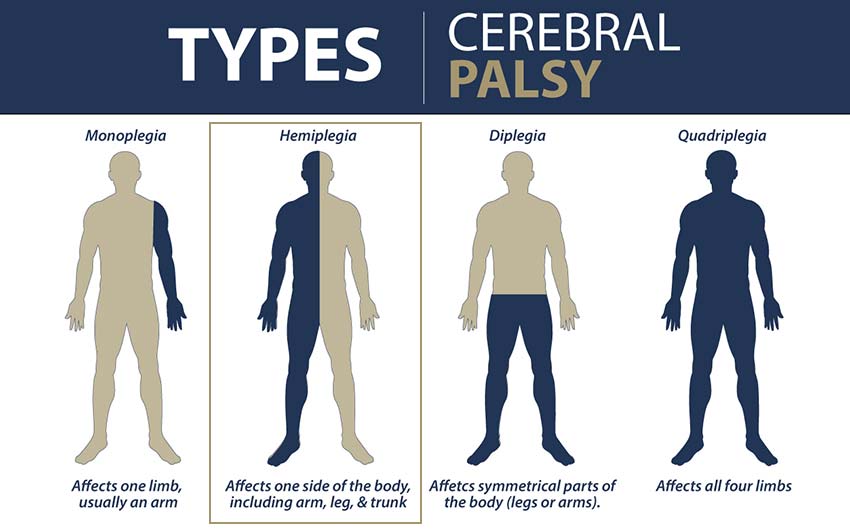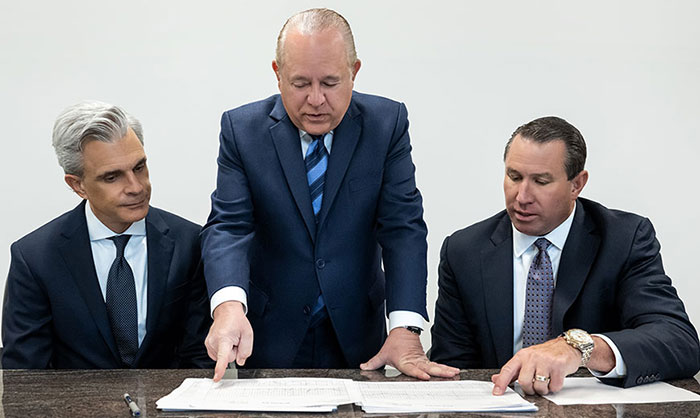Symptoms of Cerebral Palsy After Childbirth
Cerebral palsy is a complex neurological disorder that affects everyone differently. It is not just one condition, but rather a group of conditions that primarily affect a person’s posture and movement. Because cerebral palsy stems from brain damage at birth, it commonly affects cognitive functioning as well.

Symptoms of cerebral palsy are typically present during infancy and can develop during the early years of childhood. These signs and symptoms can range from mild to severe, depending on the cause and the location of the brain injury. No two individuals with cerebral palsy will have an identical experience.
A child’s cerebral palsy symptoms and complications will significantly alter their life trajectory. They will likely require specialized treatments, assistive devices and equipment, and sometimes even surgical operations like selective dorsal rhizotomy and hip muscle release procedures to treat spasticity and alleviate pain.
Learn More
About Cerebral Palsy Treatments
These treatments can place a financial strain on families, but some of that burden can be alleviated when the child’s cerebral palsy diagnosis stems from preventable medical mistakes.
When medical negligence is proven to be the cause of a child’s birth injury, a specialized birth injury attorney can help families file a medical malpractice claim. Over the past three decades, the nationally recognized team of birth injury lawyers, registered nurses, and nurse-attorneys at Miller Weisbrod Olesky have established a proven track record of delivering justice for children and families across the United States who have suffered from all types of birth injuries.
Free Legal Consultation
Cerebral Palsy Lawyers
1-888-987-0005Our Birth Injury Lawyers are available to meet you in your home or the hospital.
We are prepared to meticulously investigate the circumstances of your case, gather crucial medical records, consult with top medical experts, and fight tirelessly to secure the compensation you deserve for your child's injury.
We represent families and their children throughout the United States. You can contact us today to schedule your free legal consultation by calling our toll-free line at 888-987-0005 or by filling out our online request form. We work on a contingency fee basis, meaning you won't pay any legal fees unless we win your case. We only receive payment once you do.
What Are the Four Types of Cerebral Palsy?
A cerebral palsy diagnosis is typically classified into one of four main subgroups. Each type comes with its own symptoms that are unique to the specific area in the brain that was damaged.
There are four main types include:

Spastic cerebral palsy is the most common form of cerebral palsy, accounting for nearly 77% of all cases. Children and adults with spastic cerebral palsy typically experience high muscle tone (hypertonia) and jerky, uncontrollable movements in the arms and legs.
Dyskinetic cerebral palsy is characterized by fluctuations in muscle tone and muscle contractions (known as dystonia). Common symptoms include feeding issues, problems with posture, and difficulty controlling muscle movement.
Ataxic cerebral palsy is a rarer type that affects coordination, balance and depth perception. Common symptoms include vision impairments, speech difficulties and trouble walking.
When a baby sustains an injury to multiple parts of the brain, they may experience overlapping symptoms from the different types of cerebral palsy.
This is known as mixed cerebral palsy, and it accounts for around 10-15% of all cases.
These subgroups of cerebral palsy can indicate which clusters of symptoms will be more visible and prevalent for the child. On this page, we will take a closer look at all the different symptoms that children may experience across the cerebral palsy spectrum.
What Are the Symptoms of Cerebral Palsy?
Most symptoms of cerebral palsy relate to issues with movement and muscle tone. This stems from the brain damage at birth impacting the pathway for motor neurons to travel through the spinal cord and nervous system to trigger muscle reflexes.
The severity of these symptoms will vary from case to case depending on the type of brain injury the child has the classification of cerebral palsy they were diagnosed with.
How Does Cerebral Palsy Affect Muscle Tone?
One of the defining symptoms of cerebral palsy is having reduced control over the muscles.
Our muscles are responsible for facilitating movement. Attached to the bones through tendons, muscles are made up of thousands of tiny fibers that contract and relax in tandem to pull the bones forward.
Muscles are in a constant state of tension to maintain posture; this continuous state of tension, contraction, and resistance within the muscle fibers is known as muscle tone.

The brain injury that causes cerebral palsy disrupts the signals sent through the nervous system that direct the muscles on how to move. This can create unwanted and uncontrollable changes in muscle tone, making for irregular posture and involuntary movements like kicking, flailing, and twisting.
Spasticity
Spasticity refers to an abnormal muscle movement pattern where the muscles in the body randomly contract and tighten. It is a state of hypertonia where muscle tone is increased, resulting in stiffness and difficulty moving. These contractions will often cause spasms (also known as muscle cramps) that will add on to the child’s pain and discomfort.
Spasticity is not just limited to children with spastic cerebral palsy; children with dyskinetic and mixed cerebral palsy will also experience some degree of spasticity as well.
Rigidity
Muscle rigidity occurs when a muscle or group of muscles contract and stay contracted for an extended period. It is an extreme form of hypertonia that is present in children with spastic, dyskinetic, and mixed types of cerebral palsy. Children experiencing muscle rigidity may be unable to move and will likely be in some varying degree of pain and discomfort.
Dystonia
Dystonia is another type of hypertonic muscle problem where the muscles uncontrollably contract, similar to spasticity. However, with dystonia, the muscle contractions cause slow and repetitive twisting movements. These twisting and writhing movements are observed most commonly with the head, hands, and feet. Individuals with dystonia may also seem to shake or have tremors.
Hypotonia
While hypertonia refers to too much muscle tone, resulting in conditions like spasticity, rigidity and dystonia, hypotonia is the opposite issue of having too little muscle tone. Babies and children with hypotonia are physically described as “floppy” or “limp”, and they are often are unable to lift their head or control their neck muscles.
Severe cases of hypotonia may prevent children from meeting physical developmental milestones like sitting upright, crawling, or walking.
Cerebral Palsy and Paralysis
When one side of the brain gets injured, it can cause paralysis on the opposite side of the body. This is because the nervous system pathways cross over in the brainstem, making it so that if the left side of a child's brain is damaged during birth, the paralysis will affect the right side of their body.

Because cerebral palsy stems from a brain injury, many children experience some form of paralysis or loss of control over their body. This is seen most often in children with spastic cerebral palsy, the most common type.
Diplegia
Spastic diplegia is one of three types of spastic cerebral palsy that causes paralysis in the legs. The arms are sometimes affected as well, but to a lesser extent. The paralysis comes from unusually high muscle tone in the legs, causing the muscle fibers to randomly contract and spasm.
While some children with diplegia can walk using mobility devices, others will be unable to walk at all and will need to use and operate wheelchairs for mobility.
Hemiplegia
Spastic hemiplegia is a type of paralysis that affects an entire side of the body. This type of hemiplegia is the most prevalent form of cerebral palsy, with the arm usually being more affected than the leg. Individuals with spastic hemiplegia often exhibit stiff, rigid movements, whereas those with flaccid hemiplegia experience weakness and loose, floppy muscles.
Spastic hemiplegia can lead to chronic muscle pain, limb deformities in severe cases, and difficulty with walking or maintaining motor control. The severity and duration of symptoms of hemiplegia can vary significantly from one individual to another depending on the cause and timing of the injury.
Quadriplegia
Quadriplegia is the most severe form of paralysis, meaning that the child has no control over all four of their external limbs. Children affected with this type of paralysis will depend heavily on assistive equipment and devices to move around.
Other Cerebral Palsy Related Movement Disorders
Many children with cerebral palsy experience a combination of movement disorders. The severity of movement disorders in cerebral palsy can be associated with functional limitations and other complications, such as hip problems, feeding difficulties, speech impairments, and seizures.

Reflexes
Combined with muscle tone imbalances and risks of paralysis, the disruption in brain signals to the body from cerebral palsy can sometimes result in a child’s delayed reflexes. Hyperreflexia refers to overresponsive bodily reflexes, and it is a common symptom of neurological conditions like cerebral palsy and amyotrophic lateral sclerosis (ALS).
When the cerebral cortex or spinal cord becomes damaged, it makes it harder for the motor neurons to travel through the nervous system and command the muscles to react. This can include delayed reflexes to stimuli or reflexes without any visible trigger.
Walking Patterns
For individuals with cerebral palsy who can walk on their own, their gait (manner of walking) may be affected by issues with muscle tone and a lack of coordination. Examples of gait disturbances include:
- In-Toeing: Walking with the toes of the feet pointed inward.
- Out-Toeing: Walking with the toes of the feet pointed outward.
- Toe-Walking: Walking with an unevenly distributed amount of weight placed onto the toes.
- Limping: Walking with an unevenly distributed amount of weight placed onto one foot over the other.
- Scissor Gait: Walking with the legs crossing over each other with each step.
- Drop Foot: The inability to lift the toes and feet high enough to clear the ground, resulting in dragging.
Many children with abnormal walking patterns enroll in physical therapy to try and alleviate these issues and practice better form.
Tremors
Tremors are a type of movement disorder that cause parts of the child’s body to shake uncontrollably. It is a common symptom of ataxic cerebral palsy, but it’s also observed in other types as well. Tremors can affect all parts of the body, including someone’s voice.
Some types of anti-anxiety medications like Valium have been shown to momentarily calm tremor symptoms, but there currently isn’t a known cure to stopping them completely. One experimental treatment is injections of Botulinum toxin (Botox) to temporarily weaken muscle strain and lessen the severity of tremors.
Swallowing and Speech Disorders
Speech disorders are one of the most common symptoms for children with cerebral palsy. This is because speech requires a complex interaction between brain signals and muscle control to produce sounds and words.
The same issues with muscle control can also impact the child’s breathing and swallowing abilities, putting them at risk for respiratory and feeding issues.

In some cases, children with severe chewing and swallowing disorders may need to receive nutrients through a surgically placed gastronomy tube (G-tube). Families also may consider helping the child use alternative communication devices to facilitate speech and express specific needs.
In addition, children with cerebral palsy may also need extensive speech therapy to attempt to train their mouth and vocal cord muscles and practice forming sounds and words.
Speech and language therapy can help children with cerebral palsy strengthen the tongue, jaw, face, neck, and throat muscles involved in speech and oral motor skills, improving their ability to communicate, chew, and swallow.
Specialized therapy can enable them to have more enriching relationships with others, giving them a greater sense of independence, confidence, and self-esteem.
Seizures and Epilepsy
A seizure occurs from abnormal electrical signals firing within the brain, causing convulsions, lack of consciousness, and uncontrollable bodily movements. Epilepsy is a disorder that makes the brain more prone to these electrical signals misfiring.

Seizures range in severity and can be classified into different groups:
- Subtle Seizures: This is the most commonly type of neonatal seizure. As the name suggests, the clinical manifestations of these seizures are subtle and often overlooked. They are similar to normal reactions and behaviors, and may include erratic eye movements, flailing of the limbs, tongue protrusions and other oral movements, struggling and thrashing, and other uncontrollable movement.
- Clonic Seizures: These motor seizures are marked by rhythmic jerks, which might be localized to a specific area of the limbs or face, the diaphragm and axial muscles (mid-section), or be hemi-convulsive (one side of the body) or multifocal (coming from different parts of the injured brain).
- Myoclonic Seizures: These motor seizures are single, rapid, or repetitive arrhythmic jerks, affecting a limb, finger, or the entire body. They are seen more often in pre-term infants, which usually indicate a poor prognosis and a severe brain injury.
- Tonic Seizures: These seizures will manifest with continuous muscle contraction in the axial, limb, facial, or other muscles. They could be asymmetrical or symmetrical, generalized, focal, or multifocal.
- Infantile Spasms: These muscle spasms, marked by short jerking spells of extension or flexion, are relatively rare. They are quicker than tonic seizures but slower in comparison to myoclonic seizures.
Learn More
About Seizures and Epilepsy
Vision Impairments
Cortical visual impairment (CVI) or cortical blindness is a neurological disorder caused by damage to the visual systems in the brain. It is the leading cause of permanent vision impairments in children. Children who suffer from CVI usually have cerebral palsy (CP) and other developmental disabilities commonly caused by birth injuries to the brain like hypoxic ischemic encephalopathy (HIE).

Another common visual impairment that is a symptom of cerebral palsy is eye muscle imbalances, where the eyes cannot focus on the same object. Children with ataxic cerebral palsy also can have visual impairments that affect their coordination and depth perception, making it challenging to perform other motor functions like walking or grabbing an object in front of them.
Children with severe visual impairments may need assistive equipment and devices like glasses, eye tracking devices, and other tools to improve their ability to see and communicate.
Learn More
About Vision Impairments
Missed Developmental Milestones
A common indicator of cerebral palsy in young children is missing traditional developmental milestones during early childhood.
The first signs a child has cerebral palsy may come at a scheduled checkup with the baby’s doctor. The parents might report that their child is not sitting up, standing, or communicating as expected. The doctor may then notice physical symptoms like being too stiff or floppy.

As the child becomes older and reaches their toddler years, failure to speak or attempt making noises that mimic speech can indicate a developmental delay.
Other indications can be lack of emotion or awareness to external noises and stimuli, limited movement or reactions, and failing to display control of fine motor skills like pinching, holding items, and brushing teeth.
Early intervention is crucial for helping children with cerebral palsy who exhibit symptoms of developmental delays. Treatments, surgeries, medications, caregivers, and assistive technology can improve a child’s future and help them progress as far as possible.
Learn More
About Developmental Delays
Size Abnormalities
Babies born with brain damage are at a higher risk for size abnormalities, particularly to the head. When a child is born with a smaller-than-average skull size, it is a condition known as microcephaly. Microcephaly is a neurological condition that may occur during pregnancy when the baby’s brain does not develop properly. The condition is typically accompanied by delayed developmental milestones and seizures.
Research has shown a link between premature birth and cerebral palsy diagnoses. It is for this reason that many children with cerebral palsy are smaller on average in size.
Research studies also suggest that up to 15% of all babies born between 24 and 27 weeks of pregnancy may develop cerebral palsy.

To reduce the potential severity of cerebral palsy conditions later in childhood, healthcare providers should engage in early preventative treatment for premature babies like neonatal resuscitation and therapeutic hypothermia treatments when necessary.
Learn More
About Premature Birth
Did Medical Mistakes Cause My Child’s Cerebral Palsy?

As illustrated above, a cerebral palsy diagnosis can stem from a multitude of birth complications that interact together. And parents deserve to know when these complications are caused or amplified by medical mistakes.
Medical negligence, such as missing pregnancy complications, failing to properly monitor fetal heart rates, or needlessly delaying C-sections, can all play a role in a child’s brain damage at birth. If a family believes that any of these mistakes contributed to their child’s cerebral palsy diagnosis, legal support may be an option. A specialized birth injury attorney can review the medical records and circumstances to assess whether a viable claim for medical malpractice exists.
Parents whose children suffer from the long-term effects of birth complications, especially cerebral palsy and the life changes that come with it, deserve to know whether it could have been prevented. Our dedicated birth injury lawyers want to help you find those answers and obtain the funds necessary to improve the quality of life for your child.
Sometimes families are hesitant to reach out to a medical malpractice attorney or law firm. They may feel overwhelmed by their circumstances or are worried that a law firm will not be able to help them. But the only way to find out if you have a case is to talk to an attorney who understands how birth injuries can lead to developmental delays and other birth complications that require long-lasting medical support.
What is the Statute of Limitations in a Birth Injury Case?

A statute of limitations (SOL) is a law that sets a time limit on how long an injured person has to file a lawsuit after an accident. It is essential to understand that statutes of limitations vary based on the type of case and the state where it is filed. For instance, the deadline for birth injury claims is typically different from other claims, such as injury to personal property, fraud, contract disputes, and collection of debts.
Generally, the clock starts ticking on the date the injury occurred. However, there are exceptions to this rule, and in some cases, the statute of limitations starts when a person discovers or reasonably should have discovered an injury. When dealing with government agencies, SOLs can become even more complex.
For example, if the party that injured you was:
- A federal employee
- Employed by a military hospital, Veterans Administration facility, or a federally funded medical entity
You may need to file a birth injury claim under the Federal Tort Claims Act (FTCA). In FTCA cases, claimants must go through certain administrative procedures before filing a lawsuit. In some states, if the negligent party was a local or state government hospital or the doctors and medical providers are employees of a governmental entity, the time period in which you must give "notice" may be shorter.
If your case is filed outside of the statute of limitations, it will typically be dismissed, and you will not be eligible to recover compensation for your injuries. Determining when a statute of limitations begins on your case can be tricky. If you're considering pursuing compensation for a birth injury, contacting an attorney as soon as possible is in your best interest.
How The Birth Injury Attorneys at Miller Weisbrod Olesky Can Help?

It takes a detailed expert review of the facts and circumstances of your pregnancy and your child's birth before determining whether their cerebral palsy diagnosis came as the result of medical malpractice.
Our Process
At Miller Weisbrod Olesky, a team of committed attorneys, nurses and paraprofessionals uses our detailed medical negligence case review process to assess your potential birth injury case. We start by learning more about you and your
child and the status of meeting/missing developmental milestones.
Then we gather medical records to determine what happened before, during, and after your delivery. We call in skilled medical experts who review your records and let us know if they think medical errors could have caused your child's injuries.
If we feel medical negligence caused or contributed to the brain injury that led to your child’s cerebral palsy, we meet with you to discuss how you can receive compensation from the medical professionals who made the errors.
At no point in our legal intake process will we ask you to pay anything. The medical review of your case and the consultation are free. We only receive payment when you do. The sooner you reach out to us, the sooner we can begin investigating your case and gathering the evidence needed to support your claim.
We work on a contingency fee basis, meaning you won't pay any legal fees unless we win your case. Contact us today to schedule your free legal consultation by calling our toll-free line at 888-987-0005 or by filling out our online request form.
